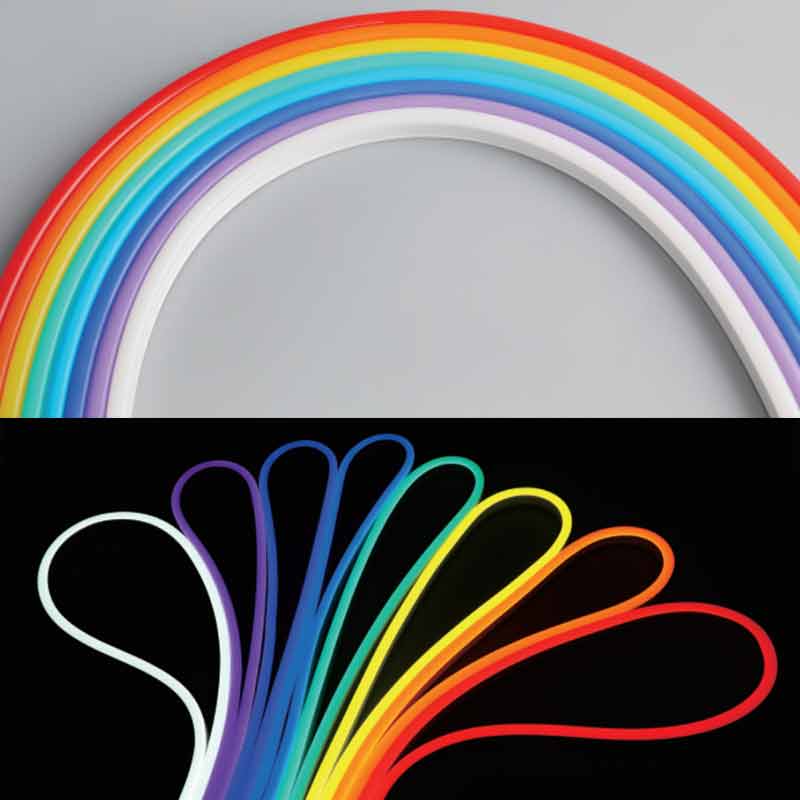How LED Neon Lights Work
2024-07-05
LED neon lights, also known as LED neon flex or LED neon rope lights, are a modern alternative to traditional glass neon lights. They offer the same vibrant glow and visual appeal of neon, but with several advantages including energy efficiency, durability, and flexibility. Here's an overview of LED neon lights, including how they work, their features, applications, and installation considerations:
How LED Neon Lights Work:
1. LED Technology:
- LED neon lights use light-emitting diodes (LEDs) to produce light. These LEDs are embedded within a flexible silicone or PVC tubing that mimics the appearance of traditional neon glass tubes.
2. Phosphor Coating:
- The LEDs emit light, which is then diffused and colored by a phosphor coating on the inside of the tubing. This coating allows for a uniform and vibrant glow similar to traditional neon.
3. Color Options:
- LED neon lights are available in a wide range of colors, including standard colors like red, blue, green, and white, as well as RGB (red, green, blue) color-changing options.
4. Flexibility:
- Unlike rigid glass tubes used in traditional neon lights, LED neon lights are flexible and can be bent, twisted, and shaped to create custom designs and lettering.
Features of LED Neon Lights:
1. Energy Efficiency:
- LED neon lights consume less energy than traditional neon lights, making them more energy-efficient and cost-effective to operate.
2. Longevity:
- LED neon lights have a longer lifespan compared to traditional neon lights, typically lasting tens of thousands of hours, reducing maintenance and replacement costs.
3. Durability:
- LED neon lights are durable and resistant to breakage, making them suitable for indoor and outdoor applications, as well as transportation and temporary installations.
4. Weather Resistance:
- LED neon lights are weather-resistant and can withstand exposure to rain, snow, UV radiation, and extreme temperatures, making them suitable for outdoor signage and architectural lighting.
5. Customization:
- LED neon lights can be customized in terms of color, brightness, length, and shape to meet specific design requirements and branding needs.
6. Low Heat Output:
- LED neon lights produce minimal heat compared to traditional neon lights, reducing the risk of burns and fire hazards, and making them safer to touch and handle.
7. Ease of Installation:
- LED neon lights are lightweight and easy to install, requiring minimal hardware and mounting accessories. They can be cut to size and installed using clips, brackets, or adhesive backing.
Applications of LED Neon Lights:
1. Signage and Branding:
- Used for outdoor and indoor signage, channel letters, logos, and branding elements in retail stores, restaurants, bars, hotels, and entertainment venues.
2. Architectural Lighting:
- Employed for accent lighting, cove lighting, under-cabinet lighting, and decorative lighting in architectural spaces, building facades, bridges, and public artworks.
3. Event Decor:
- Utilized for event lighting, stage lighting, festival decorations, and themed environments in weddings, parties, concerts, and corporate events.
4. Retail Displays:
- Integrated into retail displays, product showcases, window displays, and exhibition booths to attract attention and enhance visual merchandising.
5. Interior Design:
- Incorporated into interior design projects, home decor, accent walls, and custom lighting installations to create ambiance and add a pop of color to living spaces.
6. Artistic Installations:
- Used by artists, designers, and creatives for artistic installations, sculptures, neon artwork, and neon-inspired installations in galleries, museums, and public spaces.
Installation Considerations:
1. Power Supply:
- Choose the appropriate power supply or driver for the LED neon lights based on voltage, wattage, and load requirements.
2. Mounting Surface:
- Ensure the mounting surface is clean, dry, and flat before installing LED neon lights. Use appropriate mounting hardware or adhesive backing for secure installation.
3. Bending and Shaping:
- Follow manufacturer guidelines for bending and shaping LED neon lights to avoid damaging the tubing or LEDs.
4. Cutting:
- LED neon lights can usually be cut to size at designated cut points using a sharp blade or scissors. Follow manufacturer instructions for cutting and sealing the ends of the tubing.
5. Weatherproofing:
- Seal exposed connections and ends of LED neon lights with silicone or heat shrink tubing to protect against moisture and weather exposure, especially for outdoor installations.
6. Wiring and Connections:
- Ensure proper wiring and connections, including soldering or using waterproof connectors, to maintain electrical continuity and prevent shorts or electrical hazards.
Maintenance Tips:
1. Regular Cleaning:
- Clean LED neon lights periodically with a soft, damp cloth to remove dust, dirt, and grime, especially for outdoor installations exposed to the elements.
2. Inspection:
- Inspect LED neon lights regularly for signs of damage, discoloration, or malfunction, and repair or replace as needed to maintain performance and appearance.
3. Weather Protection:
- Check weatherproofing and seals periodically, especially for outdoor installations, and reseal or repair as needed to prevent moisture ingress and damage.
4. Electrical Safety:
- Ensure proper grounding and electrical safety precautions are followed during installation, maintenance, and operation to prevent electrical hazards and ensure user safety.
5. Temperature Control:
- Avoid exposing LED neon lights to excessive heat or direct sunlight for prolonged periods, as this may affect performance and lifespan.
LED neon lights offer a versatile, energy-efficient, and durable lighting solution for a wide range of applications, including signage, architectural lighting, event decor, retail displays, and artistic installations. By understanding their features, applications, installation considerations, and maintenance tips, designers, architects, and installers can effectively incorporate LED neon lights into their projects to create visually stunning and impactful lighting designs.



